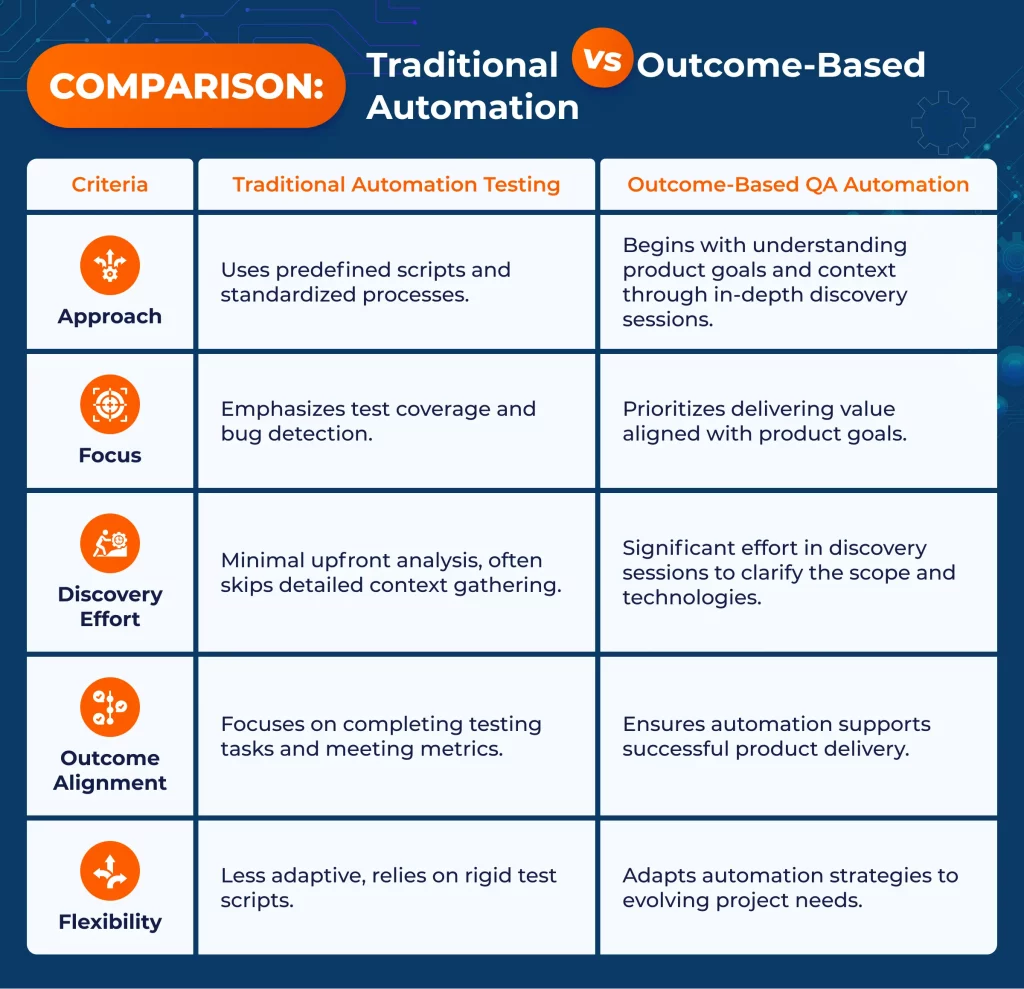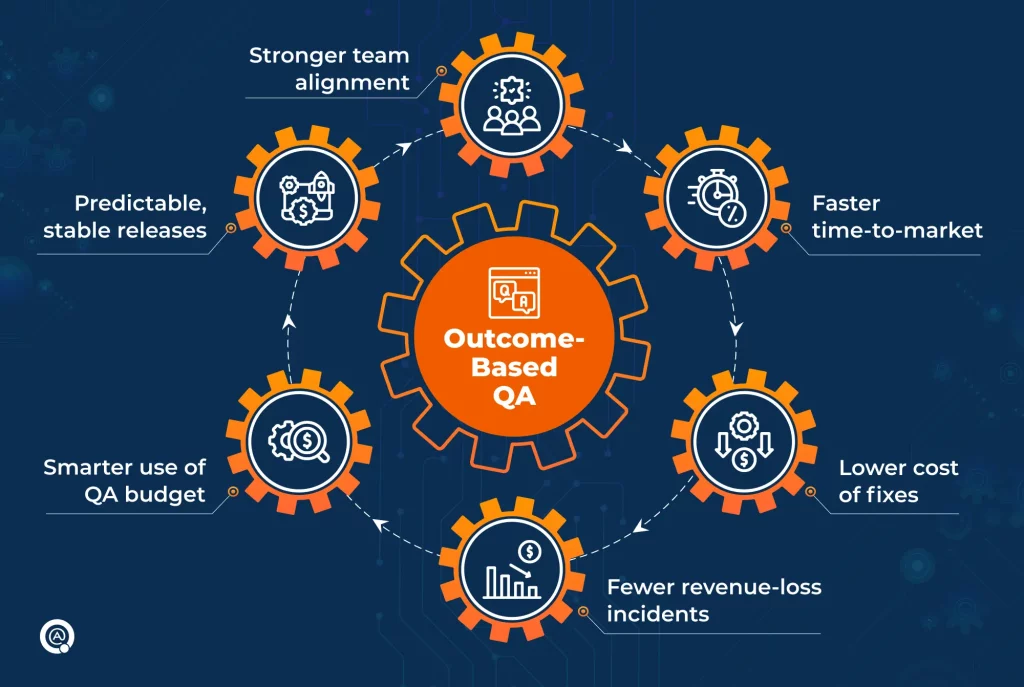Beyond Hours: Why Forward-Thinking Companies Choose Outcome-Based QA
by Tetyana Lykhitska | August 21, 2025 11:46 am
When products evolve quickly, testing must adapt just as fast. Automated testing helps cover more test cases and speeds up the entire QA team’s work. However, without the right approach, this solution won’t help you build a product that meets customer needs, aligns with business goals, or stays competitive. As a result, you’ll spend time and money maintaining automated tests but fail to succeed, putting your business’s reputation, revenue, and customer trust at risk.
At QATestLab, we use outcome-based QA. This means we begin by analyzing the project’s scope, technology stack, and quality risks to tailor an automation strategy that fits the product’s needs and business goals. This enables us to prioritize not just speed, but above all, product quality and the achievement of desired outcomes.
In this article, we’ll explain how this approach works in practice and how it helps product teams release with greater speed, stability, and confidence.
5 Reasons Automation Without Strategy Doesn’t Deliver Desired Outcomes
1. Limited Test Coverage
Without prior analysis of business requirements and user behavior, automated tests are limited to standard scenarios, failing to cover critical business processes such as accurate calculations or transaction handling.
Negative Outcome: Undetected errors in key scenarios or business processes, leading to financial losses, customer churn, and failure to achieve business goals.
2. Weak Cross-Platform Testing
Without analyzing the variety of devices, browsers, and operating systems used by customers, automated tests focus only on primary platforms.
Negative Outcome: Issues on untested platforms degrade product functionality, reducing conversion rates and damaging the company’s reputation.
3. Wasted Effort
Without a clear understanding of business goals, QA teams risk focusing their efforts on low-impact features or outdated functionality, investing time without contributing real value to the product.
Negative Outcome: Time and money are spent maintaining irrelevant tests, while overall product quality suffers, leading to user dissatisfaction.
4. No Visibility Into Business Impact
Without connecting testing to key metrics like retention, average order value, or repeat usage, it becomes impossible to evaluate QA effectiveness objectively.
Negative Outcome: Testing efforts may seem successful on paper, but fail to support business growth or meet strategic goals.
5. Lack of test flexibility
Without taking into account the analysis of potential product changes or market demands, automated tests are not designed to be flexible, making them unable to adapt to new requirements or updates.
Negative Outcome: Additional costs for test rework and product release delays reduce the software’s effectiveness on the market.
Outcome-Based QA: What It Really Means
Outcome-based QA is the approach that focuses on business alignment, faster releases, reduced risk, and better user experiences. By connecting testing directly to product and company goals, we ensure that QA efforts support what truly matters and evolve as the project does. Here’s how we put this into practice at QATestLab:
Clear, measurable goals
We define clear, outcome-focused KPIs at the start of each project. These metrics allow us to objectively measure the impact of our testing efforts, track progress over time, and ensure that our work contributes directly to the client’s business goals — not just technical completeness.
Risk-focused approach
At QATestLab, we integrate a risk-based mindset into every testing project. We start by identifying the areas of highest business and technical risk, whether it’s critical user flows, integrations, or edge cases, and prioritize our efforts accordingly. This ensures that our resources are used where they bring the most value and directly support product stability and business goals.
Agile and adaptive testing
Our team designs and executes testing processes with built-in flexibility. This ensures our team can quickly adapt to changing product requirements while maintaining a strong focus on delivering the intended business outcomes.
Embedded collaboration
We prioritize close collaboration with product teams. Outcome-based testing only works when everyone is aligned on goals, risks, and success criteria. Through clear, ongoing communication, we ensure that testing efforts stay connected to what matters most for the product and the business.
What Outcome-Based QA Means for Automation
Outcome-based automation starts with detailed discussions and requirement gathering to clearly define the project’s scope, technology stack, and desired outcomes. This ensures that the testing strategy is focused, relevant, and aligned with business goals from the outset.

Our Approach to Automated Testing
As we’ve already established, delivering successful results through automated testing[1] requires choosing the right testing approach. Let’s walk through the key stages QATestLab follows to ensure that test automation delivers real impact:
Stage 1 — Define objectives and scope
We start by aligning on goals: what automation should cover, what business outcomes are expected, and which metrics to track. This includes understanding the team structure, release cycle, technical risks, and limitations.
Stage 2 — Set up a relevant test environment
We set up the software, database, network, and compatibility layers, including browsers, operating systems, and devices, to closely simulate real-world conditions and accurately uncover potential issues.
Stage 3 — Create and maintain test scenarios
We focus on automating scenarios that directly impact users and business operations. All scripts are versioned, maintained regularly, and optimized for reusability and scalability.
Stage 4 — Select tools and framework
Our QA engineers select compatible tools such as Selenium, Cypress, or Appium that integrate smoothly with your CI/CD systems, issue tracking systems, and test management tools.
Stage 5 — Execute tests and keep them updated
We ensure testing remains effective by continuously executing frameworks, addressing any issues, and adapting tests to match product updates.
Stage 6 — Measure results and adjust
At QATeasLab, we monitor test performance, highlight areas for optimization, and leverage reporting insights to improve onboarding and enhance overall QA strategy.
If you want to see how we apply our testing approach in practice, check out our case study[2]. It shows how we helped the client strengthen their in-house QA capabilities by rapidly integrating into their development process, delivering cross-platform test automation, increasing coverage to 85%, improving release stability.
Tangible Benefits You’ll Gain with Outcome-Based QA

Faster time-to-market
Outcome-based QA doesn’t slow down releases with unnecessary checks. It focuses on what truly matters for go-live. As a result, teams often release 20–50% faster by reducing bottlenecks in testing and avoiding last-minute surprises.
Lower cost of fixes
By targeting high-risk scenarios early, QA engineers catch critical issues before they reach production. Fixing bugs earlier in the cycle reduces costs significantly, sometimes up to 6x less than post-release fixes.
Fewer revenue-loss incidents
Well-prioritized test coverage helps avoid production failures that damage trust and lead to lost users or revenue. Teams no longer have to deal with costly hotfixes or reputation risks after a release.
Smarter use of QA budget
Instead of scaling hours or writing hundreds of low-impact test cases, QA teams automate what actually supports delivery. This leads to less maintenance work, more focus, and cost savings.
Predictable, stable releases
Outcome-based QA builds trust across teams by delivering results that reduce last-minute bugs and unstable builds. Releases become easier to plan and execute, with no more firefighting on release day.
Stronger team alignment
This approach connects QA directly with product and business goals. Test priorities reflect real needs, and results become actionable for both product and engineering, helping everyone make faster, better decisions.
Conclusion
As we’ve seen, one of the key reasons automated testing often fails to deliver meaningful results is the absence of a proper strategy and misalignment with business objectives. Automation can offer speed and precision, but only when it’s designed around the product’s specific context, risks, and priorities.
If you aim to stay ahead of competitors, speed alone is not enough to ensure long-term success. What truly matters is delivering a high-quality product that meets the expectations of your users and supports your business goals. That’s exactly where our QA team can help.
If you’re looking for test automation that aligns with your product vision, mitigates risks, and accelerates value delivery, we’re ready to start. Get in touch[3], and let’s turn quality into your competitive edge.
 [4]
[4]Learn more from QATestLab
Related Posts:
- automated testing: https://go.qatestlab.com/outcome-based-qa
- case study: https://go.qatestlab.com/3VK1Qat
- Get in touch: https://go.qatestlab.com/contact-us5
- [Image]: https://go.qatestlab.com/contact-us5
- Automation Testing for Mobile Apps: Why It’s Essential and Our Key Services: https://blog.qatestlab.com/2025/05/13/automation-testing-for-mobile-apps-why-its-essential-and-our-key-services/
- QA Automation Tools: Low-Code, No-Code, or Coding-Based?: https://blog.qatestlab.com/2025/03/27/qa-automation-tools-low-code-no-code-or-coding-based/
- Unreal Automation: Boosting Efficiency and Quality in Game Testing: https://blog.qatestlab.com/2023/09/20/unreal-test-automation/
Source URL: https://blog.qatestlab.com/2025/08/21/beyond-hours-why-forward-thinking-companies-choose-outcome-based-qa/

